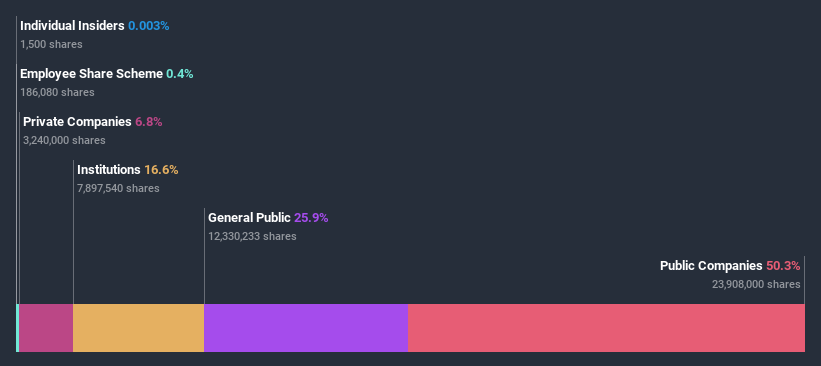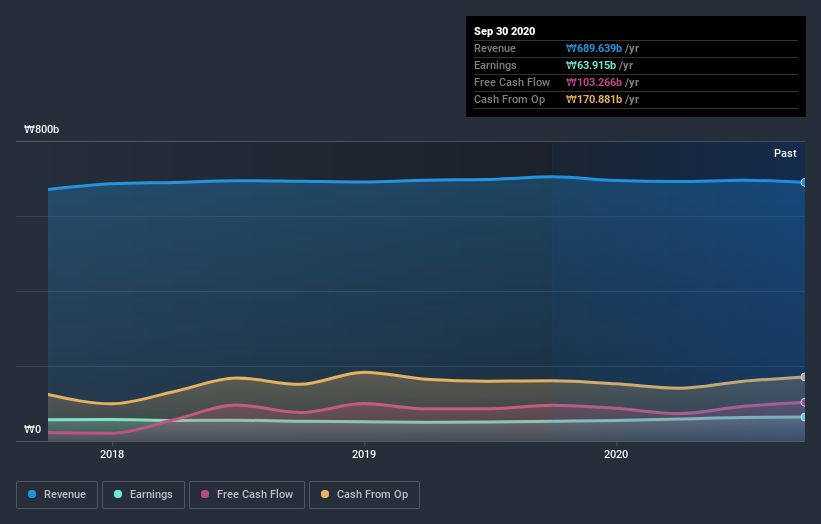- South Korea
- /
- Media
- /
- KOSE:A053210
How Many KT Skylife Co., Ltd. (KRX:053210) Shares Do Institutions Own?
The big shareholder groups in KT Skylife Co., Ltd. (KRX:053210) have power over the company. Generally speaking, as a company grows, institutions will increase their ownership. Conversely, insiders often decrease their ownership over time. We also tend to see lower insider ownership in companies that were previously publicly owned.
With a market capitalization of ₩420b, KT Skylife is a small cap stock, so it might not be well known by many institutional investors. Taking a look at our data on the ownership groups (below), it seems that institutions own shares in the company. Let's take a closer look to see what the different types of shareholders can tell us about KT Skylife.
View our latest analysis for KT Skylife

What Does The Institutional Ownership Tell Us About KT Skylife?
Many institutions measure their performance against an index that approximates the local market. So they usually pay more attention to companies that are included in major indices.
KT Skylife already has institutions on the share registry. Indeed, they own a respectable stake in the company. This suggests some credibility amongst professional investors. But we can't rely on that fact alone since institutions make bad investments sometimes, just like everyone does. If multiple institutions change their view on a stock at the same time, you could see the share price drop fast. It's therefore worth looking at KT Skylife's earnings history below. Of course, the future is what really matters.

We note that hedge funds don't have a meaningful investment in KT Skylife. The company's largest shareholder is KT Corporation, with ownership of 50%. This essentially means that they have extensive influence, if not outright control, over the future of the corporation. Korean Broadcasting System is the second largest shareholder owning 6.8% of common stock, and Shinyoung Asset Management Co., Ltd. holds about 6.2% of the company stock.
Researching institutional ownership is a good way to gauge and filter a stock's expected performance. The same can be achieved by studying analyst sentiments. We're not picking up on any analyst coverage of the stock at the moment, so the company is unlikely to be widely held.
Insider Ownership Of KT Skylife
The definition of company insiders can be subjective and does vary between jurisdictions. Our data reflects individual insiders, capturing board members at the very least. The company management answer to the board and the latter should represent the interests of shareholders. Notably, sometimes top-level managers are on the board themselves.
Most consider insider ownership a positive because it can indicate the board is well aligned with other shareholders. However, on some occasions too much power is concentrated within this group.
Our information suggests that KT Skylife Co., Ltd. insiders own under 1% of the company. But they may have an indirect interest through a corporate structure that we haven't picked up on. It appears that the board holds about ₩13m worth of stock. This compares to a market capitalization of ₩420b. I generally like to see a board more invested. However it might be worth checking if those insiders have been buying.
General Public Ownership
With a 26% ownership, the general public have some degree of sway over KT Skylife. While this group can't necessarily call the shots, it can certainly have a real influence on how the company is run.
Private Company Ownership
It seems that Private Companies own 6.8%, of the KT Skylife stock. It might be worth looking deeper into this. If related parties, such as insiders, have an interest in one of these private companies, that should be disclosed in the annual report. Private companies may also have a strategic interest in the company.
Public Company Ownership
It appears to us that public companies own 50% of KT Skylife. It's hard to say for sure but this suggests they have entwined business interests. This might be a strategic stake, so it's worth watching this space for changes in ownership.
Next Steps:
While it is well worth considering the different groups that own a company, there are other factors that are even more important. Case in point: We've spotted 2 warning signs for KT Skylife you should be aware of, and 1 of them is concerning.
If you would prefer check out another company -- one with potentially superior financials -- then do not miss this free list of interesting companies, backed by strong financial data.
NB: Figures in this article are calculated using data from the last twelve months, which refer to the 12-month period ending on the last date of the month the financial statement is dated. This may not be consistent with full year annual report figures.
If you decide to trade KT Skylife, use the lowest-cost* platform that is rated #1 Overall by Barron’s, Interactive Brokers. Trade stocks, options, futures, forex, bonds and funds on 135 markets, all from a single integrated account. Promoted
Valuation is complex, but we're here to simplify it.
Discover if KT Skylife might be undervalued or overvalued with our detailed analysis, featuring fair value estimates, potential risks, dividends, insider trades, and its financial condition.
Access Free AnalysisThis article by Simply Wall St is general in nature. It does not constitute a recommendation to buy or sell any stock, and does not take account of your objectives, or your financial situation. We aim to bring you long-term focused analysis driven by fundamental data. Note that our analysis may not factor in the latest price-sensitive company announcements or qualitative material. Simply Wall St has no position in any stocks mentioned.
*Interactive Brokers Rated Lowest Cost Broker by StockBrokers.com Annual Online Review 2020
Have feedback on this article? Concerned about the content? Get in touch with us directly. Alternatively, email editorial-team (at) simplywallst.com.
About KOSE:A053210
KT Skylife
Engages in the digital satellite broadcasting business in South Korea.
Undervalued with excellent balance sheet.
Similar Companies
Market Insights
Community Narratives





